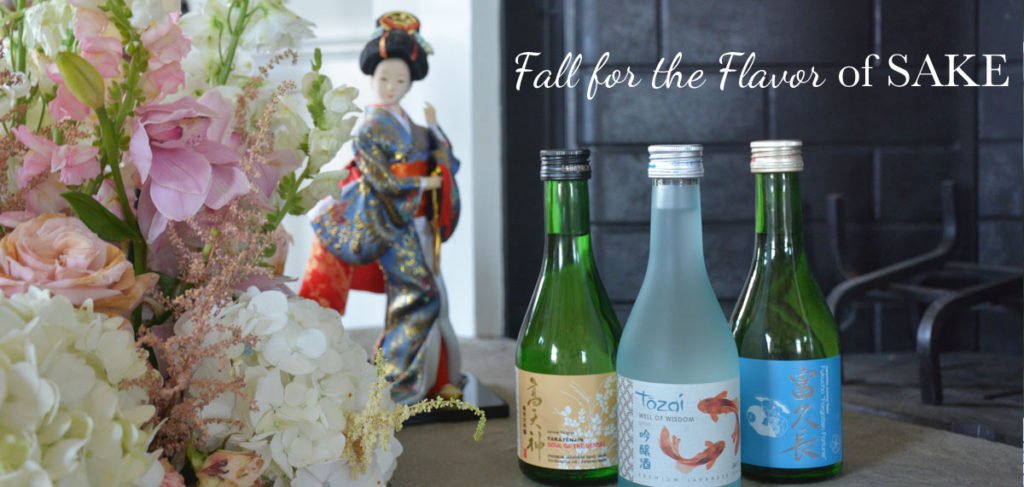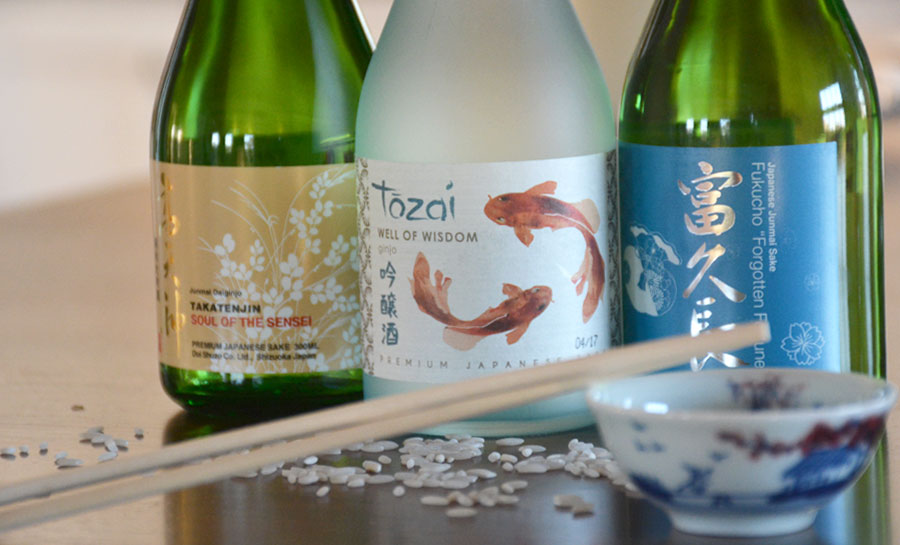
FALL for the Flavor of Sake
October 2, 2017CELEBRATING NIHONSHU NO HI
While summer is the quintessential season for many people on Nantucket, those of us who are lucky enough to be on island this time of year know that the weather associated with our Indian Summer and the lack of crowds this time of year are a just reward for the hustle and bustle of July and August. As we enter in to fall, this is the prime time for sake drinking. Brewed during the cold winter months and then pressed in the spring, sake is typically aged six months and then released in the fall for your enjoyment. What better way to celebrate the upcoming Nihonshu no Hi (Sake Day) on October 1, traditionally the starting date of sake production in Japan, than with a toast to this alcoholic beverage of Japanese origin made of fermented rice.
What is sake?
Sake is an alcoholic beverage that is made by fermenting rice. My first experience with sake many moons ago was when it was served warm as an accompaniment to sushi – at a ski resort in Montana, no less. Sake that is typically served like this is usually not that good as heating it up will only mask the awful flavors of the bad sake. Like wine, sake can be served and enjoyed at a variety of temperatures based on how well the sake performs at that certain temperature and also your taste preferences (note: scalding hot shouldn’t be one of those options). Also similar to wine, there are different categories of sake. But instead of talking about grape varieties such as Chardonnay or Cabernet, we talk about sake in terms of how much each grain of sake brewing rice is milled. Thus, categories of sake are established by polishing/milling percentages irrespective of the rice varietal. This refers to how much each grain of rice is removed from the outside husk in the attempt to get at the starchy core inside of each grain the brewing rice.
One of the most common words seen in reference to sake is the term Junmai. While this category does not have a milling requirement, it refers to the absence of any distilled alcohol. Some brewers do add a small amount of distilled alcohol to the brewing process to bring out different flavors, aromas, and textures in the sake. Like using oak on a fine wine, this production method is a decision made based on breweries’ discretion and what they would like the outcome of their final product to be.
Seimaibuai (say-my-boo-eye) is the word you need to know in reference to the grade and category of sake. It refers to how much of a grain of brewing rice is polished or milled. For the sake grade Ginjo, the rice has been milled 40%, with a value of 60% of the rice remaining. Daiginjo refers to at least 50% of the rice has been polished away leaving 50% of the core of the grain that will then be fermented. When combining the two key words Junmai and Seimaibuai, you will be able to distinguish the various commonly accepted grades of sake: Junmai meaning the absence of distilled alcohol, and Seimaibuai referring to the milling value for each sake. Definitely learning a new language here, but once you have the basics you will be order your favorite sake (and find the restroom later).
How to taste Sake
Tasting sake is also similar to wine. First, you look at the color of the sake. Another helpful term is Nigori, meaning that the sake has been unfiltered. Then you will smell the aromatics of the sake, looking for fruit and mineral, earthy components. Take a sip of the sake and confirm the same or different tastes on the palate that you sensed on the nose, along with considering such factors as sweet versus dry, the amount of acidity and the length of the taste lingering in your mouth. When trying to learn about the different styles, it is recommended to sample no more than four different selections at a time to get you started on your sake tasting certification. Here are a list of suggestions that not give you a cross section of styles, the names are quite entertaining as well.
This is a lovely, entry-level easy drinking introduction to sake. The rice has been polished enough that you can tell it is sake, but it isn’t too much that you feel like you are chewing on the rice itself. Well of Wisdom draws its water source from the town of Fushimi, which means “hidden water” and is known for its characteristically soft and pure water that is perfect for brewing sake. It has tropical fruit aromas with a refreshing white pepper finish. This is perfect on a warm Indian Summer Day or as an aperitif before heading to dinner.
Food pairing: Shrimp skewers and citrus based ceviches
 Fukucho Junmai “Forgotten Fortune”
Fukucho Junmai “Forgotten Fortune”
Fukucho is the only brewer to use the rice used to make this sake. It is a strain that had been abandoned by brewers despite being the parentage of several other rice varieties, hence the name. They painstakingly revived it along with farmers who had to relearn to grow it. This sake has loads of earthiness on the nose, layers of texture and is bold and full flavored on the finish. Bonus: Female owner and brewer!
Food pairing: Locally farmed Nantucket oysters
 Dassai Junmai Daiginjo “Otter Fest 23”
Dassai Junmai Daiginjo “Otter Fest 23”
Dassai blends the best ingredients with old fashioned experience and cutting edge technology. This sake is polished to an unprecendented and highly difficult 23% polish ratio, therefore the number designation in the name. It offers a delicate fruity aroma of honeydew melon and McIntosh apples with a refined flavor on the palate, making it full bodied yet slightly sweet. This sake also happens to be Kosher.
Food pairing: Tuna sashimi
 Suigei Tokubetsu Junmai “Drunken Whale”
Suigei Tokubetsu Junmai “Drunken Whale”
The term Tokubetsu means that the sake is very special and has been made from rice stalks specifically grown for sake making. The rice grains have been milled more than average, making this a very labor-intensive sake to produce with a strong ricey flavor. The nose has floral, woodsy aromas. On the palate, it has moderate texture and viscosity yet is very dry. An extremely clean sake, the Drunken Whale is for the serious sake drinker.
Food pairing: Royal Oscietra Caviar
New to sake drinking? Don’t be intimidated by the pretty labels and character symbols that you may not be able to interpret just yet. Most US importers of sake know it can be overwhelming, albeit daunting, when you first get started. That is why they typically have a handle little chart on the back label of the sake bottle to decipher what you will be enjoying from the inside of the bottle. Kanpai!


Comments